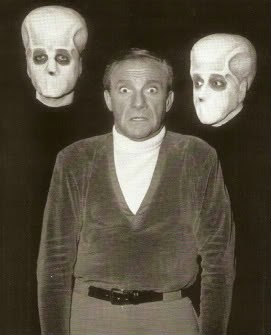A
reader, David, writes:
“Here’s an Ask JKM a
Question for you.
All the entertainment
in the world is being systematically destroyed and you get to save only one
episode of Star Trek for future
generations.
Which episode do you
save?”
Yikes!
Now that’s a tough question, David.
I’m
going to narrow it down a little. Since
you didn’t specify any sub-title, I’m going to assume I can only choose an episode
of the original series, not the follow-ups. (If I could pick a Next
Gen episode, it would be “The Inner Light.”)
But
let me walk you through my thought-process in terms of my selection. If only one episode of Star Trek is to survive
for future viewings, I must consider which episode in the canon highlights best
the core elements of the series; which best represents everything Star Trek
stands (or stood…) for.
Some
of my favorite episodes, like “Space Seed,” or “The Trouble with Tribbles”wouldn’t necessarily make the cut. They
are great shows, but I wouldn’t want either to be my representative Trek.
I’d
have to drill-down here a little and answer a key question, I suppose: what does Star Trek
mean to me?
Well,
it’s about friendship. (Kirk, Spock and Bones).
It’s
about the idea of man going out into the unknown and taking his humanity with
him.
It’s
about confronting alien life.
It’s
about learning to see others (aliens, etc.) in a new and different light.
It’s
about resourcefulness on the frontier, on the edge of civilization, when no one
is around to back you up. You have great technology, but that technology is no
guarantee of survival, or victory in battle.
I’ve
been poring over the episode list and I believe have one episode that hits all
those hot spots.
It’s
not my favorite show, though it’s a good one. It’s not even in my top twenty
favorite Treks. (Among my favorites: “This Side of Paradise,” “Amok
Time,” “Metamorphosis,” “Journey to Babel,” “Charlie X,” “The Doomsday Machine,”
and “The Enterprise Incident.”)
But
I would choose “The Corbomite Maneuver.”
This
episode from early in the first season finds the Enterprise encountering a
giant cube in space (no, not the Borg).
Captain
Kirk reluctantly orders it destroyed when it emits dangerous radiation. Before long, a much larger alien ship -- the
Fesarius -- arrives and threatens the Enterprise. Its captain is the fearsome and very alien
Balok.
Now
Kirk must figure out a way to escape from the technologically-superior ship,
and the merciless Balok.
I
would choose this episode, first, because there’s a clear surrogate for the
audience in the narrative. We meet young
Lt. Bailey (Anthony Call), who is anxious and scared, having never encountered
anything alien. He’s nervous and
burdened by responsibility.
Dr.
McCoy thinks Bailey was promoted (by Kirk) too soon, but Kirk sees something of
himself in the green officer. He sees a man who can learn and grow. This
character -- who voices audience fears and concerns -- helps us to understand
the nature of the Star Trek universe, and the nature of the choices Kirk must
make.
The
episode also features some good back-and-forth in the heroic triumvirate, with
McCoy needling Kirk about his weight, and Spock and Kirk discussing poker and
chess.
Furthermore,
“The Cormobite Maneuver” involves humanity encountering alien life, and not
knowing what to expect from it. In that vacuum, tension rises.
Man brings with
him to the encounter both his inexperience (Bailey) and his experience (Kirk),
which makes for a nice balance, and a nice complete picture of man as a
species.
And
the episode’s finale involves a reveal about the true nature of Balok, and the
way that “fear” is a universal constant. Kirk, Bailey and McCoy board Balok’s ship only to find that the “alien”
is a puppet, and that the real Balok is a child-like alien. He
only presented that other face because he was as fearful as Bailey was about the unknown.
But,
optimistically, this means that man and alien are alike. They feel the same things; they fear the same things. This is a basis for
friendship.
Kirk
is up against the wall in this episode, matched against a superior ship and
superior powers. But he uses a bluff -- from the game of poker -- to find a path to survival. He could easily fail, but he doesn’t.
And when he “wins,” Kirk shows mercy to his
enemy, and curiosity about his enemy too.
This act shows that mankind has truly grown-up. That given the chance, he can choose not to kill,
or hurt another life form.
It
was tough to make this call, but “The Corbomite Maneuver” is representative of Star Trek’s
best ethos, and I think the presence of the rookie, Bailey, makes the episode
easier for newbies to identify with.
I'd love to read choices by readers of the blog...





















































